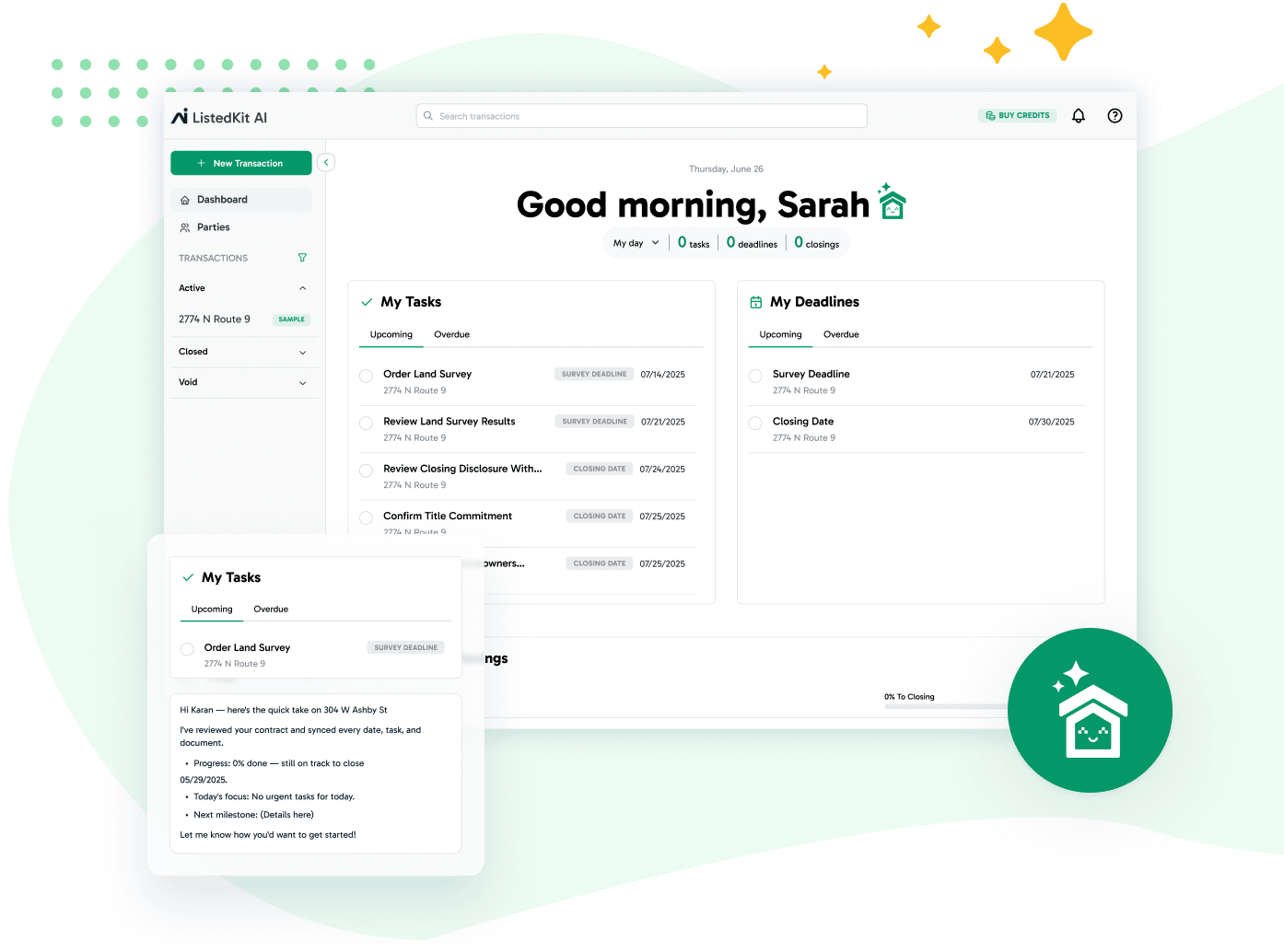As a transaction coordinator (TC), you know that no two agents are alike. Each brings their personality, communication style, and approach. Adapting to these differences is essential for fostering productive relationships and ensuring successful deals when working with real estate agents.
This guide is designed to help transaction managers navigate the nuances of working with different agent personalities. We’ll cover:
- Recognizing common agent personality types and strategies for working effectively with each.
- Creating a solid onboarding process to gather key agent preferences and priorities insights.
- Customizing workflows to align with agent needs and improve efficiency.
- Implementing communication strategies that foster clarity, reduce misunderstandings, and strengthen relationships.
By the end, you’ll have actionable tools to simplify your coordination process and deliver a seamless experience for every real estate deal.
Understanding Agent Personalities
The real estate industry is diverse, and so are the agents transaction coordinators (TCs) collaborate with daily.
Understanding agent personalities is critical to effectively navigating the real estate transaction process.
Below are some typical agent personalities you may encounter and actionable tips for working with them.
Detail-Oriented Agents
These agents focus on every minor element of the transaction process. They meticulously review purchase agreements, inspect essential documents, and expect frequent updates to stay in control.
How to Work With Them:
- Create a detailed document checklist covering key deadlines, loan application deadlines, and escrow account updates.
- Use real estate transaction management tools like Dotloop for Teams to share real-time progress on tasks.
- Keep them informed about the escrow file, inspection periods, and commission instructions.
- Example: An agent reviews every line of a closing statement. TCs can reduce back-and-forth questions and ensure client satisfaction by providing them with a current file.
Big-Picture Thinkers
These agents focus on outcomes like closing deals, ensuring client relationships are maintained, and delivering excellent customer service. They leave administrative tasks and detailed tracking to the TC.
How to Work With Them:
- Summarize updates using concise email templates.
- Highlight milestones in the transaction process rather than granular details.
- Example: For these agents, use digital tools to create dashboards that outline the progress of transactions under contract without overwhelming them with irrelevant data.
High-Pressure Agents
Often managing a high transaction volume, these agents value speed and efficiency. They are frequently on the move, juggling multiple real estate deals.
How to Work With Them
- Leverage task batching to streamline updates and handle multiple requests at once.
- Automate reminders for critical document submissions or key deadlines.
- Example: A TC sends automated updates through estate transaction management software to ensure all tasks are on track without interrupting the agent’s daily activities.
Collaborative Agents
These team players value open communication and see TCs as partners in the transaction coordinator role. They are eager to share feedback and refine workflows.
How to Work With Them:
- Schedule weekly meetings to review transactions under contract and discuss any potential improvements.
- Involve them in decisions about task assignments, especially if you’re using virtual transaction coordinator tools.
- Example: A collaborative agent works with you to align timelines, ensuring all administrative assistants and escrow agents stay on the same page.
A skilled transaction coordinator knows that adapting communication styles to agent preferences can make or break the collaboration. Not every agent communicates the same way, so flexibility is key.
Disclaimer: Please note that these are based on generalizations and are not exhaustive categories. We’re not saying that each agent will fit into one specific type, as personalities often overlap or evolve based on circumstances. Use these insights as a flexible guide to adapt your approach when collaborating with different agents.
The Importance of Onboarding
An effective onboarding process sets the tone for the entire transaction process. It allows TCs to learn about the agent’s working style, priorities, and expectations. Here’s how to make the most of onboarding:
- Preferred Communication Channels. Discover how each agent prefers to communicate. For example, some agents rely heavily on email templates, while others may prefer phone calls or even virtual meetings.
- Frequency of Updates. Determine how often they want updates. For instance:
- A detail-oriented agent may need updates daily or after every milestone.
- Big-picture thinkers may prefer weekly summaries.
- Agent Priorities. Learn whether speed, compliance, or the client experience is the top priority. For example, an agent focused on marketing efforts may ask for updates on virtual tours or digital marketing progress.
- How to Gather Information. Use tools like surveys or questionnaires to gather insights about agents during the initial contract stage.
Setting Clear Expectations
Establishing clear expectations during onboarding is essential for ensuring a smooth transaction. Transparency and clarity help avoid frustrated clients and misaligned goals.
- Tips for Setting Expectations:
- Outline the transaction coordinator role, including the scope of your responsibilities.
- Share an initial timeline that includes deadlines for property inspections, broker file submissions, and commission disbursement.
- Use a client database to log important details for future reference, such as the agent’s experience level and preferred workflows.
Building a Trusting Relationship Early
Trust is the foundation of any strong working relationship. By demonstrating organizational skills and reliability during onboarding, TCs can foster confidence from the start.
- Strategies for Building Trust:
- Share examples of successful deals you’ve coordinated in the past.
- Explain how tools like estate transaction management software will support the agent’s day-to-day tasks.
- Actively listen to feedback or concerns to show you value their input.
- Real-World Example. If you’re working with a virtual assistant or managing multiple real estate transactions, explain how the team structure ensures no aspect of the closing process is overlooked.
Why Onboarding is Essential
By gathering information, setting expectations, and building trust, onboarding helps TCs reduce friction and create workflows that align with the agent’s needs. This leads to smoother transactions and happier clients.
Customizing Workflows for Better Collaboration
To create an ideal transaction process, workflows should cater to the specific needs of the agent.
- For Detail-Oriented Agents. Break down tasks into smaller steps, ensuring critical documents are tracked and submitted on time.
- Example: Create a progress report for the escrow file and keep the agent updated daily.
- Big-Picture Thinkers. Focus on the bigger milestones, like contract deadlines or the closing statement, rather than the administrative tasks leading up to them.
- Fast-Paced Agents. Streamline communication by consolidating updates into a single daily or weekly report.
Using Digital Tools to Support Workflows
Transaction coordinators can rely on digital tools to manage the varying demands of real estate agents. Tools like ListedKit and Dotloop can centralize the transaction process, reducing the time spent on administrative tasks.
- How to Use Digital Tools Effectively:
- Assign tasks within the platform so agents can easily check their status.
- Automate reminders for tasks like document requests, ensuring all essential documents are submitted on time.
Setting Up Regular Checkpoints
Periodic check-ins are vital for keeping workflows on track.
- How to Implement Checkpoints:
- Schedule weekly calls to review the current file and discuss any pending tasks.
- Use email templates for updates to save time while maintaining consistency.
- Encourage agents to share market insights or feedback that could improve the process.
The Role of Technology in Customization
Tech solutions simplify workflow adjustments and provide visibility into the real estate transaction process. By leveraging these tools, TCs can align their efforts with the agent’s specific preferences, whether it’s for marketing materials, property inspections, or client communications.
The Result of Customized Workflows
Customized workflows lead to improved client relationships, better communication between clients, and fewer errors during transactions. Agents feel supported, and clients enjoy smoother transactions, resulting in potential client referrals and long-term partnerships.
Tips for Effective Communication
Smooth communication is essential for maintaining strong working relationships in real estate transactions. By adopting structured approaches and thoughtful strategies, transaction coordinators can reduce miscommunication and enhance collaboration with agents and clients.
Maintain Professional and Concise Messaging
Clear, focused communication process is vital to keep everyone informed without overwhelming them. Agents often deal with high transaction volumes, making brief and structured messaging a practical choice.
- Strategies for Clarity:
- Organize emails with headings, bullet points, or numbered lists to make updates easier to digest.
- Use subject lines that immediately convey the purpose, such as “Inspection Period Update for [Property Address].”
- Provide only essential details while linking additional resources or supporting files for those who need them.
- Example:
- When sending updates about property inspections or document requests, a brief email might read:
- “Subject: Inspection Period Update – [Address]
- Hi [Agent Name],
- Inspection Scheduled: [Date and Time]
- Deadline for Reports: [Deadline]
- Next Step: Submit findings to the escrow agent by [specific date].
- Let me know if you have questions!”
This format keeps the agent informed while saving time for both parties.
Be Proactive With Communication
Anticipating what agents might need or clarifying potential sticking points before they arise is key to effective communication.
- Actionable Tips:
- Send reminders about key deadlines, such as finalizing commission disbursement or submitting escrow documents.
- Highlight potential gaps, such as a missing signature on the initial contract or overdue documents.
- Offer solutions to simplify tasks. For example, include links to e-signature tools when requesting documents.
- Example: A TC working on a real estate deal notices a document missing from the broker file. Instead of waiting for the agent to follow up, the TC sends a quick note:
- “Hi [Agent Name], I noticed the [Document Name] hasn’t been uploaded yet. Let me know if you’d like assistance retrieving or submitting it.”
Document Preferences and Use Templates
Keeping a record of agent preferences can significantly enhance communication efficiency, especially for those managing multiple transactions or working as independent transaction coordinators.
- Practical Approaches:
- Use estate transaction management tools to log each agent’s preferred method of communication, be it text messages, calls, or emails.
- Save email templates for recurring updates, such as weekly progress reports, inspection follow-ups, or closing reminders.
- Example: If an agent prefers phone updates for urgent matters and email summaries for ongoing updates, logging this preference into your client database ensures communication is consistent and effective throughout the entire transaction process.
The Outcome of Better Communication
By focusing on clarity, being proactive, and personalizing communication, transaction coordinators strengthen relationships with real estate agents. These strategies lead to more efficient workflows, better collaboration, and, ultimately, smoother transactions that keep agents and clients satisfied.
Strengthen Collaboration and Simplify Transactions
Managing real estate transactions successfully requires transaction coordinators to adapt to various agent personalities and preferences. By applying structured processes and maintaining clear communication, you can enhance collaboration and achieve smoother transactions.
Here’s a quick recap of how to elevate your coordination approach:
- Understand agent personalities: Recognize how detail-oriented agents, big-picture thinkers, high-pressure agents, and collaborative agents work, and adapt your communication style accordingly.
- Prioritize onboarding: Gather insights into each agent’s preferences, define responsibilities, and build trust early to set the tone for a productive partnership.
- Customize workflows: Use tools to align timelines, tasks, and progress tracking with agent needs, ensuring efficiency and reducing friction.
- Communicate effectively: Be clear, concise, and proactive to keep agents informed and confident in the transaction process.
Refine your strategies, foster better relationships, and achieve seamless transactions—Get started for free with ListedKit today.




